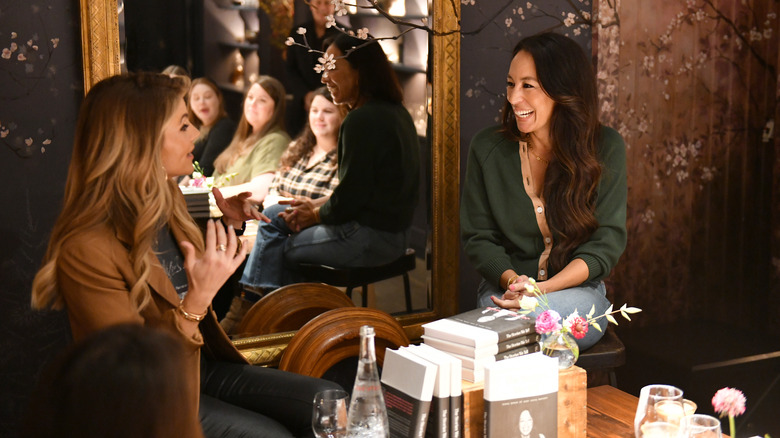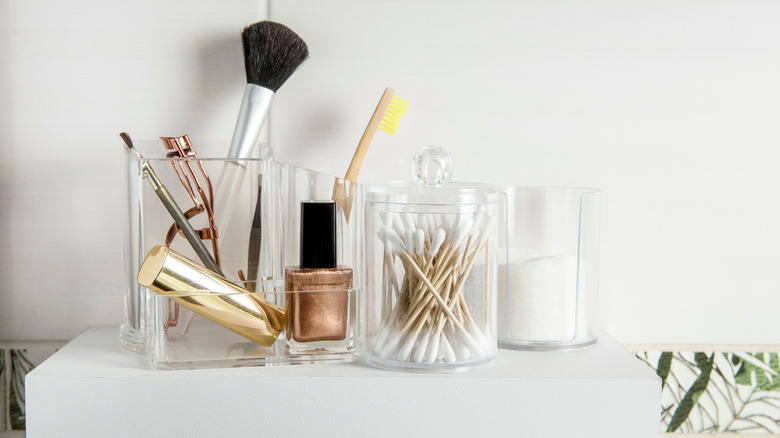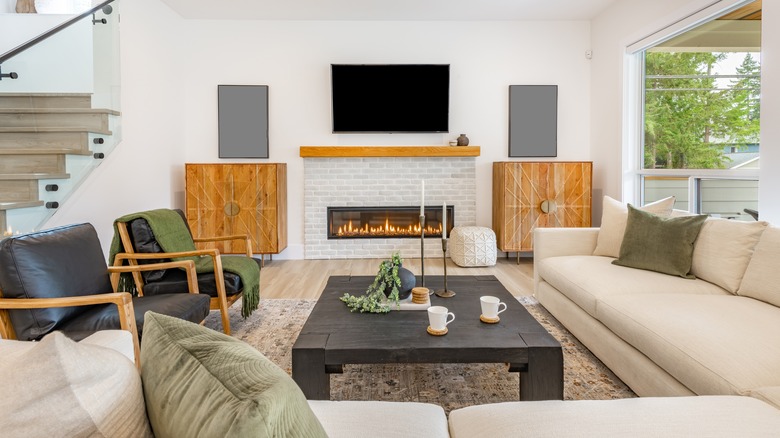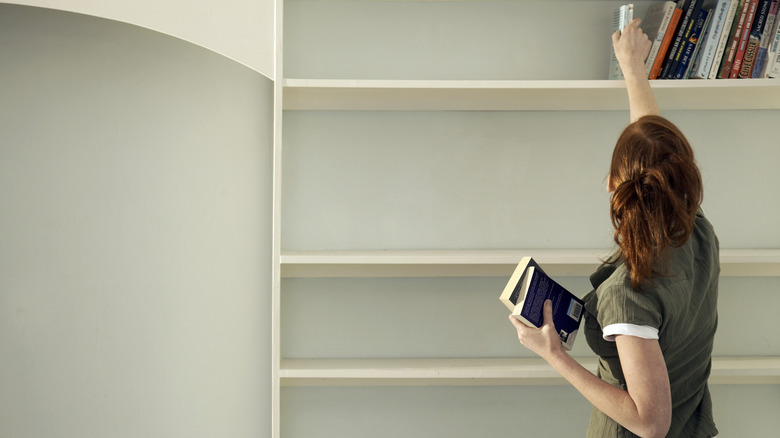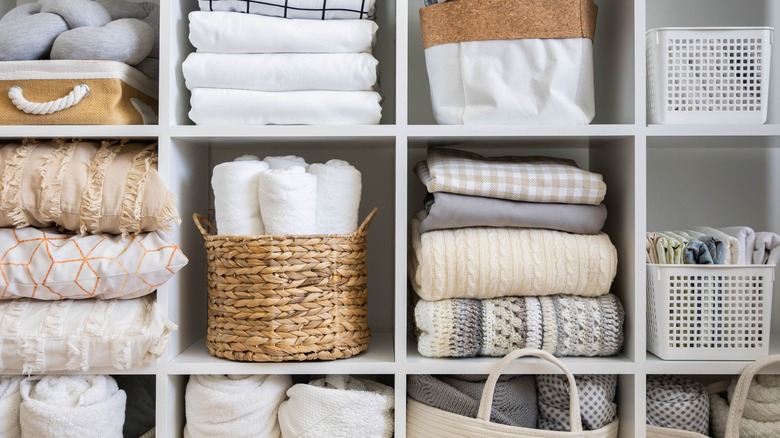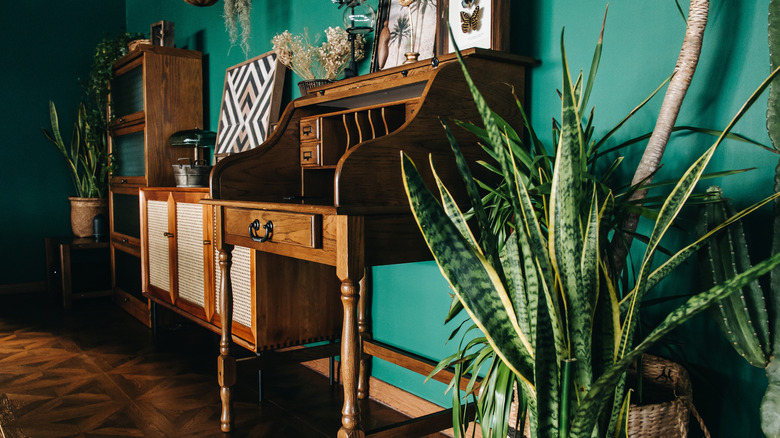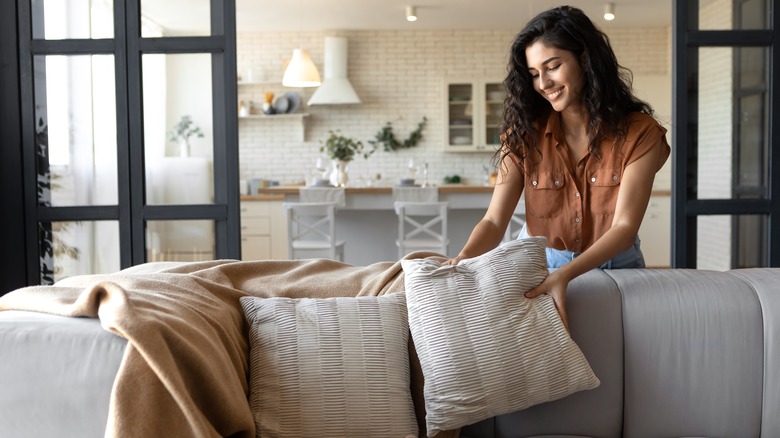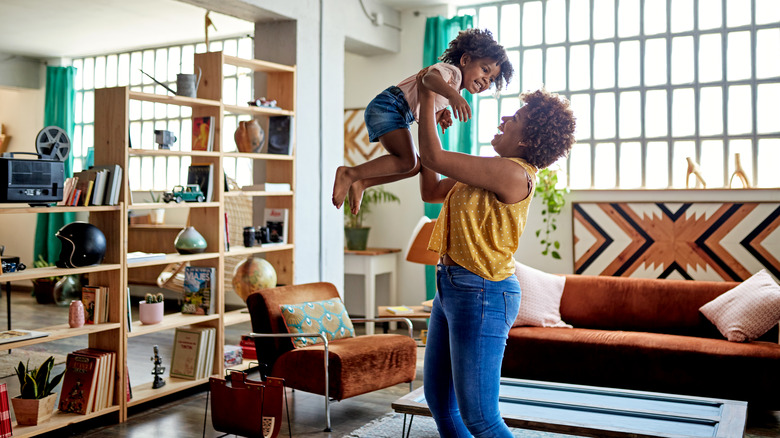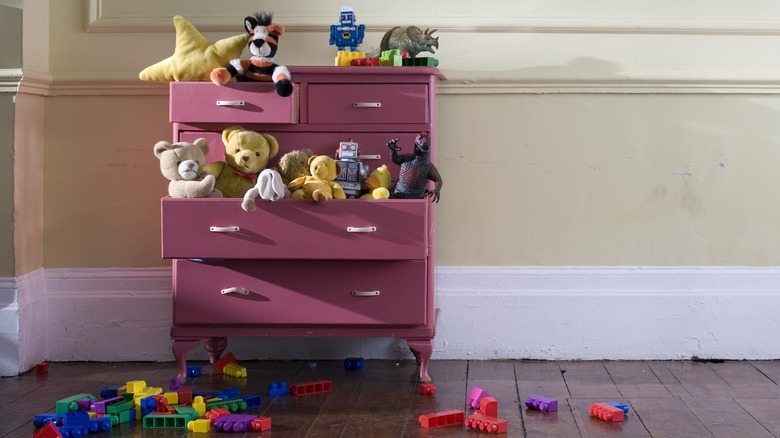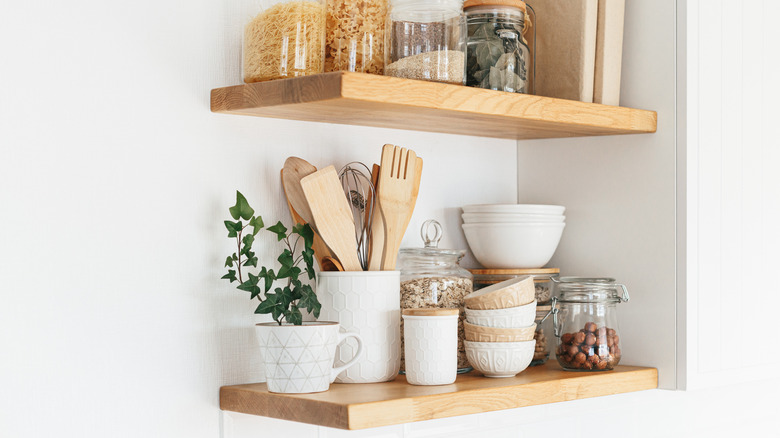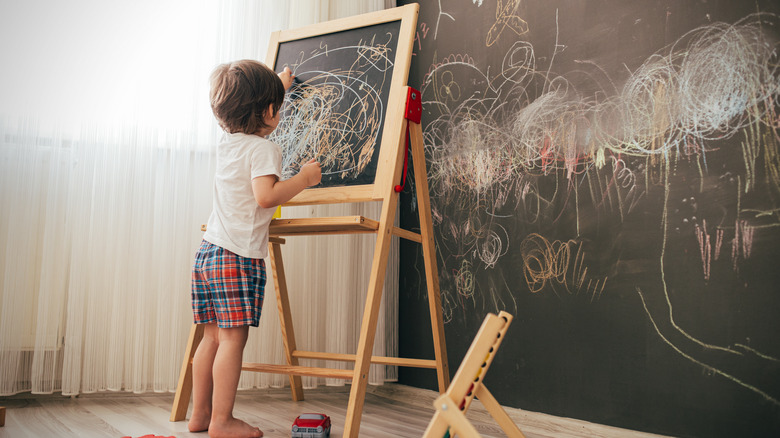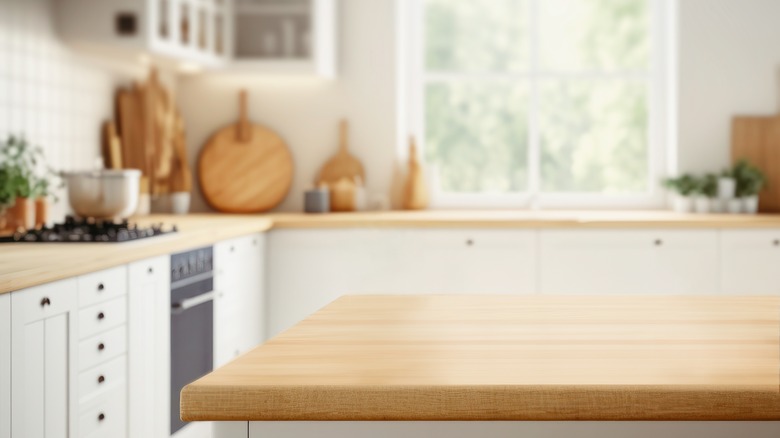Joanna Gaines' Go-To Styling Tips That Also De-Clutter Your Home
We may receive a commission on purchases made from links.
There's no two ways about it: Clutter is an aesthetic killer. It's also insidious. Like weeds in a lawn, it can slowly grow and take over, to the point where your house doesn't seem to have a free surface or a room that feels neat and organized. Not only does clutter look bad, but it can also make it hard to operate in one's home. Cleaning is way more complicated if you have to battle chaos at every corner, and finding everyday items can turn into a 20-minute project. But how do you get out of the clutches of clutter?
If you're looking for answers, who better to take tips from than Joanna Gaines, OG interior designer, home flipper, brand founder, and busy mom. The Gaines family has grown as prolifically as the Magnolia empire, and with a large family comes — you guessed it — lots of potential clutter. But the "Fixer Upper" star seems to reign in the chaos at home just as efficiently as she handles renovating castles and hotels. Gaines has got more than a few practical styling tips that will not only elevate your home, but bust clutter. From turning toys into décor to looking beyond classic storage solutions, the ex-HGTV host has some hot takes. If you want practical advice that also looks good, get comfortable and keep reading.
Showcase your essentials (but in a cute way)
One of the ways Gaines combats clutter is by displaying everyday items and even household supplies. This might sound counterintuitive, but intentionally showcasing essentials can make for a stylish and orderly look. Joanna Gaines told The Delite "By having things out in the open and in cute containers, you actually reduce the clutter." The secret is simply in how you present them. In her book "Homebody" (via The Delite) Gaines says, "The fun thing about being creative with the way you contain things is that things that typically wouldn't be cute, like cotton balls and Q-Tips, you can make it cute by getting cute little glass jars and putting them in a basket."
In other words, ditch the branded packaging in favor of attractive jars, baskets, and bottles. Bring bathroom items up out of the vanity and within easy reach on your counter. To make your hand and dish soap into a statement, decant it into attractive dispensers. If you like a simple, streamlined look, glass canisters with bamboo lids like these on Amazon could be ideal. Or if you're after a touch of glam, you could also pick up something similar to these faceted amber glass jars from Amazon. And don't think this styling trick is confined to the bathroom; feel free to get decorative with your pantry supplies by decanting them into matching containers. The same trick can be applied to anything from alcoholic spirits (which can look super sexy if poured into decanters and displayed) to office and cleaning supplies.
Create cubbies you can easily customize to change storage needs
Another go-to tip from the interior titan is to tap into the customizable power of cubbies. A row of cubbies will give you an eye-catching bank of storage that you can easily adjust as your needs evolve. Joanna Gaines outlines in her book "Homebody" (as per The Delite), "As time goes on, you can add to it, take away, [or] modify it." Cubbies can act as accessible storage for children's items, like shoes, toys, or school supplies, but they can also be super practical for grownups. In an Instagram post, Gaines showed off her picture-perfect laundry, complete with a dreamy cubby cabinet featuring black wire baskets.
If you're a highly visual person who needs items in sight, rather than hidden behind closed cabinet fronts, you can copy this combo with something as simple as an IKEA KALLAX unit and some inexpensive wire baskets from Amazon. For a more concealed look, opt for solid bins or woven baskets. Cubbies don't just help you cut clutter, they're also a great styling opportunity. You can use free cubbies for displaying décor, break up the front by alternating between boxes and more decorative things like books, and style the top like you would a credenza. Besides doubling as a semi-sideboard, you can also incorporate cubby storage into seating. This is one of the most popular KALLAX DIYs to date. Simply turn a single-row KALLAX unit on its side, and boom! You've got yourself a bench into the bargain.
Go bigger with décor and furniture for a less cluttered feel
Unless you're a master of minimalism, your home probably has to hold a pretty sizable amount of things. Finding the right storage solutions can help visually streamline your space, but you may also want to evaluate your furniture choices. Do you have lots of smaller furniture items? This can create a cluttered feel, especially if your rooms aren't very spacious. During an episode of "Fixer Upper," (via Homes & Gardens) Joanna Gaines shared that, "in tighter spaces, people think you have to go smaller, but I always like to do the opposite." A few larger items of furniture can help ground the space, add impact, and create a focal point. This doesn't mean you have to go hard on overstuffed, bulky furniture pieces. For instance, in a small living room, a large rug can make the room feel more expansive.
Bookshelves are another great example. Lots of smaller shelving units in one space is probably going to look less elegant and impactful than one larger unit. A single long credenza will be a centerpiece, while a couple of small console tables could create a cluttered feel. The same principle can hold true for décor. If you have a tray of trinkets, swapping these out for a single sculptural piece can help reduce visual busyness. Art is another area where you may definitely want to consider upsizing. There is no law that says small rooms must have small pictures — on the contrary, oversized art can totally transform tiny spaces, making them feel confident and larger than life.
Get strict with what you keep out
While there are ways to make typically unattractive home items (like cotton pads and Q-tips) become décor, there are some things that just aren't cute, no matter what you do with them. If you want an editorial feel for your home, you may need to take a leaf out of Joanna Gaines' book, "Homebody," where she writes (via Los Angeles Times), "I became pretty critical about what we [keep] out in the open." Here, she is specifically referring to the bedroom, but you can apply this tip to your entire home. It's easy to get into the habit of keeping things out and within arm's reach, and before you know it, your counters, tabletops, and coffee table are their permanent home.
To reset this situation, take a hard look around your space and decide what actually needs to be on display. If you don't make toast every day, the toaster probably doesn't need to take up valuable space on your countertop. It might be handy to have device chargers laying out, but maybe there's a way you could conceal them. For instance, a pack of magnetic cable clips from Amazon will let you neatly hang charger cables at the back of your desk or sideboard for less than $20. When styling décor and the things that you do want to keep out, containing items on trays can also help reduce visual clutter.
Bins and baskets are your best friends
If you want décor to do double duty as storage solutions, what could be more perfect than a collection of cute catch-alls? Portable storage solutions like baskets, can easily be moved around and take up less space than something like a bulky credenza. During an interview with Architectural Digest, Joanna Gaines said, "If you don't have room for a piece of furniture, use unique baskets, bins, and crates that help organize the mess." She also guides readers to, "Look for practical pieces that tell a story and fit your style. These may take longer to find, but they'll be worth the wait."
In other words, instead of picking up a bunch of generic baskets from Target, take a look around at your local thrift stores and flea markets. If you're a fan of the modern farmhouse style, be on the lookout for rustic items you can repurpose, such as wooden milk crates or something similar. This doesn't mean you can't buy new bins or baskets, just make sure you pick materials and styles that align with your home's aesthetic. One of the easiest ways to collect unique storage containers is to support artisans such as weavers and woodworkers. Buying a handmade basket might cost more initially, but it will a pop of personality to your space.
Look out for unique pieces to catch clutter
Speaking of unique pieces, this is one of Joana Gaines's tenants for stylish storage. When chatting with Architectural Digest, she shared, "A great way to stay organized is to create intentional spaces for toys, craft supplies, and odds and ends. I think storage is the most undervalued part of a home. Adequate storage can make every room feel more peaceful and beautiful simply by removing clutter and freeing up visual space. I like to purchase unique pieces that offer a lot of practical organizational space. For example, I bought an old wood chicken feeder at an antiques store that I love." Gaines continued, "It's the perfect 'built-in' organizational area."
You might be wondering, how does one go about sourcing these funky finds? A really original piece, like a chicken feeder, is tailor-made for a farmhouse, but it might not quite tie in with a New York penthouse. Look for pieces that are both original, but also match your aesthetic. Things like vintage filing cabinets, apothecary units, bar carts, hutches, and storage ottomans are some great examples of hardworking furniture pieces that can help you house miscellaneous home items. There's no rule that says you can't buy some of these solutions new, but if you want a unique look, thrift shops, estate sales, and online second-hand marketplaces can help you find one-of-a-kind items at affordable prices.
Know when to stop adding décor
Creating a beautifully styled space often comes down to knowing what to keep and what to take away. If you aren't able to edit your décor, it can overwhelm your home, compete for attention, and create a cluttered atmosphere. One of the trickiest parts is knowing how much is too much for your personal preference and style. When asked by The Seattle Times how many decorative accents are enough and when do they start turning into clutter, Joanna Gaines said, "A lot of this is gut instinct. What I feel is enough may not be enough for others. I think when you're looking at your space and you feel like, 'OK, I think I've got it,' you can stop."
The great thing about styling a home is that nothing is ever set in stone, except very fixed features like tile. When it comes to décor, your house is your oyster. You can move, rearrange, and pair back styled areas to your heart's content. To get a feel for how much detail you like, start experimenting. Play around with your coffee table, create stacks of books, add candles, and throw in a vase and big flower bouquet for a full, busy look. Then perhaps strip it back to a very basic vignette. Think: a single coffee table book, a candle, and a snuffer. Somewhere in between, you'll find your sweet spot.
Let your home tell a story
Another way you can cut down on clutter and execute great style is by tapping into the unique story of your home and the people in it. Picking a design style can help you create a cohesive look, but following one to the letter won't make your house a home. One of the best ways to make sure your space is a reflection of you and your family is to display objects that are uniquely personal. During her interview with Architectural Digest, Joana Gaines said, "In my opinion, what sets a home apart is when you focus on your family's story, rather than a style ideal. Find pieces that speak to you, and give yourself the freedom to tell your story in your own unique way."
Telling the story of your family isn't something that happens in an afternoon, so don't put too much pressure on yourself. Instead, approach it as an ever-evolving process. One of the easiest places to start is with a gallery wall. Take some of your favorite family photos and mix in other mediums and pieces of art such as vintage posters, paintings, and wall hangings. You can also print out photos of places you love or locations that are particularly meaningful to your family. If you have kids, frame some of their pictures. Display your favorite books, show off mementos from trips, or objects that have been handed down through your family.
Get stylish with kids' storage
Keeping clutter at bay is hard enough as an adult, but once kids enter the picture, this raises the stakes. Packing toys away after play isn't, ahem, instinctual for most kids, and the more complicated it is for them to stow something, the higher the barriers to building packing-away habits. To make it easy, one of Joanna Gaines' tricks she revealed in a since deleted blog post is to start with simple storage options for small toys that the kids can easily access. "I bought basic containers to store these smaller things in so the kids know where they go when they are finished playing with them," wrote Gaines. "I also think it looks super cute out on the dining table or coffee table as intentional décor for the kids."
Another way you can be creative with housing kids' toys and busting clutter is through quirky, thrifted décor and furniture pieces. The supermom and TV mogul said in a "Fixer Upper" episode (per HGTV Asia) that, "One of the things I love to incorporate in kids' spaces are funkier pieces." In the scene, she packs an array of colorful crayons into a vintage tool caddy. "This was an old toolbox, and so I always think it's fun to find containers and things that you wouldn't typically put colors in."
Install open shelving to prevent surfaces from getting cluttered
If you're a Joanna Gaines fan, then you probably know that open shelves are one of her favorite moves. In an Instagram post, the star said, "Open shelving looks good just about anywhere and I love how it displays the items I use most while also helping me stay organized." Not only do they present a storage and styling opportunity, but open shelving can also give off a light, airy, streamlined feel, provided you arrange their contents right.
If you're not sure how to get a set of open shelves looking Instagram-worthy, Gaines has another top tip up her sleeve. In her book "Homebody" (via The Delite), Gaines shared, "When I'm doing open shelving, a trick that I like to use is using a grid that goes in a diagonal form. For instance, if you have a plant on the upper right-hand side of the top shelf, you put a plant diagonally below it."
Worried your open shelves will make your space look more cluttered? An easy trick to ensure you get space to stash stuff you don't want to see is to invest in some closed storage solutions you can incorporate into the shelving. For large shelving units, this could look like interspersing objects on display with boxes and baskets that can hold less attractive, more utilitarian items. For narrower floating shelves, you can line them with cute tins, jars, and containers that can hold smaller odds and ends.
Create a chalkboard wall for the whole family
Joanna Gaines also loves a good chalkboard moment. During an interview with Design Mom, she said, "I encourage clients to paint a section on their wall with chalkboard paint and trim it out if they have the extra space. Kids love coloring on the walls, so why not let them? Chalkboards are also a great tool for personalizing your space; for instance, if there is a family verse or mission statement, a chalkboard is a great tool for this."
Not only do chalkboards give kids a place to get creative, but they can also help parents streamline the number of drawings and art projects on display. To up your organization game even further, you may want to create a mini art station below the board where you can keep chalk sticks and other art supplies. And if you don't have kids, a chalkboard could still be a good idea. Not only is it a fun place to write inspirational quotes, but you can also use it for quickly jotting down to-do lists, notes, and meal planning.
To make your own chalkboard on the wall, all you have to do is pick up some blackboard paint, tape off a section of wall using a level and painter's tape, and apply it. If you'd like, you can add some wood trim, but if you're not up to this extra DIY step, feel free to leave it as-is, or go bold and paint out an entire accent wall in chalkboard paint. You can also get creative with this idea by opting for a color other than black (this brand of chalkboard paint on Amazon comes in various hues).
Gain control over kitchen countertop clutter by corralling items and clearing away non-essentials
According to a survey conducted for the Duck® brand (via PR Newswire), kitchen countertops attract the most clutter. If you've ever studied the physics of kitchen countertops, you may have observed that they behave similarly to black holes. The more objects they hold, the greater the gravitational pull, creating a vicious cycle that sucks in clutter like a magnet. Fortunately, Joanna Gaines has a game plan for decluttering kitchen counters. She advises that you, "clear your counter of everything but the essentials," in her book "Homebody" (via PureWow).
Is your counter crowded with small appliances? Gaines says to stow these "away in the pantry or a cabinet along with any other small appliances that aren't used every day" (via Yahoo!). This will help stop uninvited items from joining the crowd. Unless you're using something daily, it probably shouldn't be out. For the things you do want on your counters, contain them so they don't become growing clusters. You can use trays to corral loose items, or employ another tip from Gaines' book and use "cutting boards to keep items organized."
If you aren't blessed with a boatload of kitchen storage, you may also want to look into smart solutions that will make the most of your cabinet space. This can help you contain any excess that's flowing onto your counters. Risers, pot organizers, and racks you can mount on the inside of cabinets (like these door organizers from Amazon) can allow you to seriously maximize your cabinet real estate.

